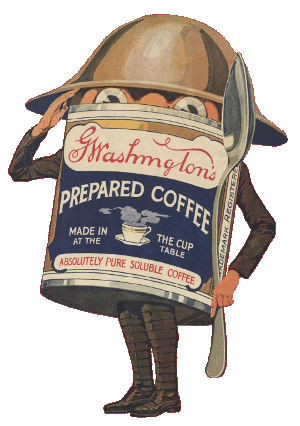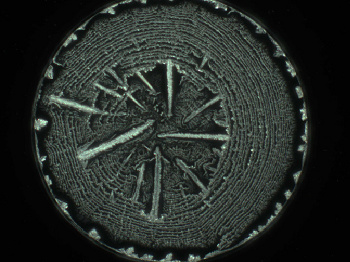Coffee Rings
December 10, 2010
Paul Erdos accomplished so much in mathematics that he's credited for at least one thing he didn't do. He's often cited as the source of the quotation, "A mathematician is a device for turning
coffee into
theorems," since he
consumed large quantities of the liquid. This quotation is believed to have been spoken by another prominent mathematician,
Alfréd Rényi. In any case, coffee is important enough to be taken seriously by mathematicians, and my own experience in research indicates that it's a respected tool of the trade for
physical scientists. It's no wonder that
physicists have taken to looking closely at
coffee rings on their desktops.
The first observations of coffee rings were done in 1997 by Robert D. Deegan and his colleagues at the
James Franck Institute and the
University of Chicago.[1,2] They discovered that the mechanism for formation of a coffee ring is as follows:
1. The liquid surface is pinned at its contact line with the substrate.
2. The liquid evaporating at the exterior edge, which is the larger liquid reservoir, is replenished by liquid from the interior.
3. There is a constant flow of liquid from the interior to the exterior.
4. This flow carries nearly all dispersed solids towards the edge.
Of course, physicists never stop at just a qualitative explanation, so they determined that there is a particular
power-law that describes the growth of the mass of the ring as a function of time. This power-law is independent of the substrate type, carrier fluid, or the dispersed solids, which means it happens not just for coffee, but for other
colloidal fluids on other surfaces as well.[1] Rings form even when droplets are dried upside-down. Along with coffee, the Chicago team verified the effect with red wine, milk, tea and soup.
The ring effect is lessened for fluids with a high
Marangoni number, since
Marangoni flow will transport some material back to the center of the ring.[3] It's been shown that for some
organic fluids, preferential deposition occurs at the center of the ring because of the Marangoni flow caused by an evaporation-induced surface tension gradient.[2] Even in the absence of Marangoni flow, there's competition between the various physical processes taking place in the colloidal droplet, so you would expect the coffee ring behavior to vary quite a bit between materials. If the liquid evaporates much faster than the particle movement, there will be no ring.[3] Size matters, since it was found experimentally that for 100 nm particles, the minimum coffee ring size is 10 μm.[4]

Washington's Coffee ad. Rotogravure image from the New York Tribune, June 22, 1919
Can coffee ring dynamics produce useful structures? A paper presented at last month's 63rd annual meeting of the
American Physical Society Division of Fluid Dynamics showed that periodic band structures can be formed with proper choice of initial conditions. The paper, "Coffee ring deposition in bands," by Shreyas Mandre (
Brown University), Ning Wu (
Colorado School of Mines), Joanna Aizenberg (
Harvard University) and Lakshminarayanan Mahadevan (Harvard University) reports that if the particle concentration is below a threshold, the deposit appears as periodic bands oriented parallel to the contact line.[5,6] This effect is a result of a competition between the speed of evaporation speed and the speed of deposition. The authors were able to develop a mathematical model that predicts the pattern that's formed. Similar patterns have been seen in non-colloidal droplet drying (see figure).[7]

Concentric rings observed in salt deposits from a drying two mm droplet.
Fig. 1 of Ref. 7, via arXiv.
A video of ring formation that includes data on the avalanche of particles at the edge can be found at Ref. 8. The experiment shown in the video used a droplet containing one micrometer particles of
fluorescent polystyrene. The particles were in a concentration 7x10
9 particles per cc in 3μl of water on a glass slide at 23
o at 30%
relative humidity.[8]
The stimulative effect of coffee is primarily from
caffeine, (C
8H
10N
4O,
1,3,7-trimethyl-1H-purine-2,6(3H,7H)-dione). The concentration of this varies according to coffee type and preparation, as follows (approximate values):
•Espresso: 30-40 mg per ounce
•Drip coffee: 16-25 mg per ounce
•Instant: 10-15 mg per ounce
•Decaf, brewed: 0-0.1 mg per ounce
Mathematicians and scientists should stick to coffee and eschew the new
caffeinated alcoholic energy drinks. The US
Food and Drug Administration issued a warning on November 17, 2010, that it considers caffeine to be an "unsafe food additive" when added to alcoholic malt beverages.[9]
References:
- Robert D. Deegan, Olgica Bakajin, Todd F. Dupont, Greb Huber, Sidney R. Nagel and Thomas A. Witten, "Capillary flow as the cause of ring stains from dried liquid drops," Nature, vol. 389, no. 6653 (23 October 23, 1997), pp. 827-829.
- Diana Steele, "Coffee stains - Fundamental physics revealed in a drop of java," University of Chicago Chronicle, vol. 17, no. 3 (Oct. 23, 1997).
- Hua Hu and Ronald G. Larson, "Marangoni Effect Reverses Coffee-Ring Depositions," J. Phys. Chem., vol. B110, no. 14 (March 23, 2006), pp 7090-7094.
- Xiaoying Shen, Chih-Ming Ho and Tak-Sing Wong, "Minimal Size of Coffee Ring Structure," J. Phys. Chem., vol. B114, no. 16 (March 31, 2010), pp 5269-5274.
- Shreyas Mandre, Ning Wu, Joanna Aizenberg and Lakshminarayanan Mahadevan, "Coffee ring deposition in bands," Abstract No. RU.00007 of the 63rd annual meeting of the American Physical Society Division of Fluid Dynamics (Long Beach, CA, November 23, 2010)
- Jason Socrates Bardi, "The physics of coffee rings," American Institute of Physics Press Release, November 23, 2010
- Vladimir A. Belyi, D. Kaya and M. Muthukumar, "Periodic Pattern Formation in Evaporating Drops," arXiv Preprint, December 21, 2006.
- Alvaro G. Marin, Hanneke Gelderblom, Jacco Snoeijer and Detlef Lohse, "Video: Avalanche of particles in evaporating coffee drops, arXiv Preprint, October 15, 2010.
- US Food and Drug Administration, "Update on Caffeinated Alcoholic Beverages," November 17, 2010.
- This Blog, "Coffee Rings and Nano Things," May 9, 2007.
- This Blog, "Morning Coffee," April 9, 2008.
- Coffee Ring Page on Wikipedia.
Permanent Link to this article
Linked Keywords: Paul Erdos; coffee; theorem; Coneheads; consume large quantities; Alfréd Rényi; physical scientists; physicists; coffee rings; James Franck Institute; University of Chicago; evaporation; power-law; colloid; Marangoni number; Marangoni flow; organic compound; Washington's Coffee; New York Tribune; American Physical Society; Division of Fluid Dynamics; Brown University; Colorado School of Mines; Harvard University; fluorescent; polystyrene; relative humidity; caffeine; caffeinated alcoholic energy drinks; Food and Drug Administration.